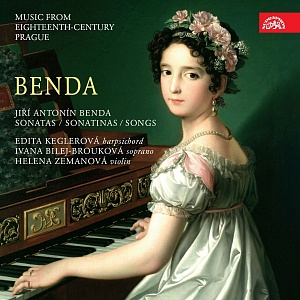
BENDAS MUSIC IS A SOURCE OF CONTAGIOUS JOY
Says harpsichordist Edita Keglerová


Jiří Antonín Benda spent his halcyon years at King Friedrich II’s orchestra in Berlin and serving as court Kapellmeister in Gotha, yet his music was played, listened to and followed in 18th-century Prague too. The city hosted performances of his singspiels, prints of his pieces sold like hot cakes. Benda was primarily known for his melodramas and singspiels, whose novel and striking forcibility even enthralled the young Mozart. The greatest impact on his piano works was made by Benda’s Berlin colleague Carl Philipp Emanuel Bach. The first of the six volumes of Benda’s Sammlung was published in 1780. The collection contained sonatas and sonatinas for keyboards, as well as arias from sacred works, sonatas for several instruments and songs. It was an extraordinary success and the number of subscribers clearly outstripped that to a similarly conceived collection of sonatas compiled by C. P. E. Bach, which started to be published a year earlier. Benda’s music is engrossing in its simplicity, impressive expressiveness, nobleness and wit.
The artists featured on the new recording – the harpsichordist Edita Keglerová, the soprano Ivana Bilej Brouková and the violinist Helena Zemanová– have become enthralled by Benda’s musical world and have succeeded in proving that its spell is contagious. We talked to Edita Keglerová on the occasion of the new release (SU 4184–2):
How would you define Benda’s music which you have recorded on the new Supraphon album?
Benda’s music is a sheer joy! It is immensely colourful, replete with sensitivity (in line with the Empfindsamkeit style) and abounding in wit. Jiří Antonín Benda had a great sense of humour, which makes his personality and work very close to my heart. And I have spent twelve years of my life with his music. I began focusing on Benda’s works in detail back during my doctorate studies at the Academy of Performing Arts, particularly his concertante pieces.
What surprised you most when recording the CD?
I really enjoyed working with the team who participated in the recording, both my fellow artists and everyone else. We were tuned into the same wavelength, with absolute ease, amenity and a good mood reigning among us. The recording took place at the chateau in Jičín, whose Assembly Hall has splendid, inspiring acoustics, which further helped to underline our performances. Jiří Antonín Benda himself studied in Jičín for some time and so we could feel his spirit there beside us (laughs). I also greatly enjoyed the research relating to the seeking of music materials. Perhaps the most difficult thing was to finish the project. It was in the pipeline back in 2012 and since that time various circumstances forced my colleague Ivana Bilej Brouková and I to remake the conception of the album and the project several times. But the result has finally been worth it. I am happy that we stuck with it.
What are your concert plans for the next few months?
The soprano Ivana Bilej Brouková and I will be giving a concert in Regensburg featuring this Benda programme. The flautist Julie Braná and I are currently preparing a chamber concert to mark the J. S. Bach anniversary. I am scheduled to appear as a soloist with Hypochondria, the Prague Baroque Ensemble and Barocco sempre giovane at performances of Jiří Antonín Benda’s harpsichord concertos, which will mark the composer’s current anniversary within the Prague Symphony Orchestra’s cycle of early music, held by the Friends of Prague Spring. In December I’ll be touring Japan with the Prague Baroque Ensemble.